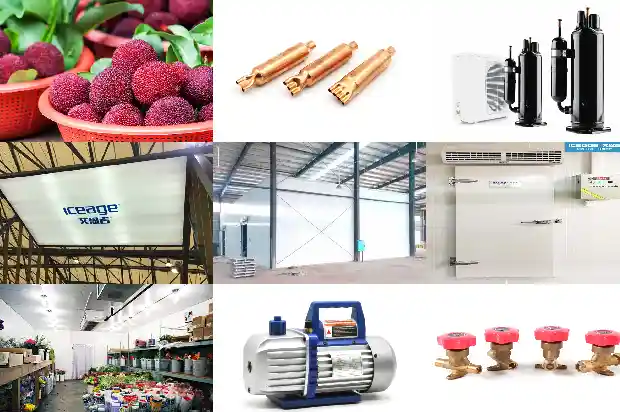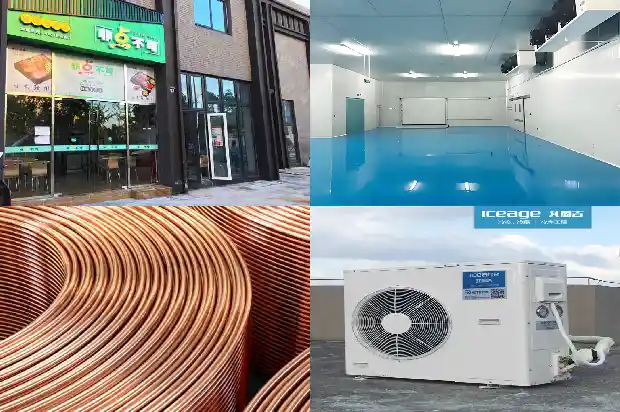Principles, Characteristics, Selection and Precautions of Air-cooled Modular Units
2025-04-11
I. Main Characteristics of Air-cooled Modular Units
- It is a central air conditioning unit that uses air as the cold (heat) source and water as the cooling (heating) medium. That is, the condenser is a finned heat exchanger, and the evaporator is a heat exchanger applied for heat exchange between water and refrigerant, such as shell-and-tube, shell-and-coil, and plate heat exchangers.
- As an integrated device that can be used as both a cold and heat source, the air-cooled heat pump eliminates various auxiliary components such as cooling towers, cooling water pumps, boilers, and the corresponding pipeline systems. The system has a simple structure, saves installation space, is convenient for maintenance and management, and saves energy. It is especially suitable for areas with a lack of water sources.
- Air-cooled heat pump units are usually an effective supplement that is preferentially selected in the design of heating, ventilation, and air conditioning projects where it is cold in winter and hot in summer, there is neither a heating boiler nor a heating network, or the heating time of the heating network is short and unstable, but year-round air conditioning is required.
- The centralized or semi-centralized central air conditioning system composed of it and terminal devices such as fan coil units and air handling units has advantages such as flexible layout and diverse control methods.
- Applicable environmental conditions. Cooling: The environmental condition is 21℃~43℃, and the inlet and outlet water temperatures of the refrigerant water are 12/7℃; the higher the outdoor ambient temperature, the worse the cooling effect. Heating: The environmental condition is -15℃ (theoretically) ~ 20℃, and the inlet and outlet water temperatures of the heating medium water are 40/45℃ (generally); the lower the outdoor ambient temperature, the worse the heating effect.
II. General Structure and Configuration of Air-cooled Modular Units
Compressor: Mainly scroll compressors and screw compressors.
Plate Heat Exchanger: Each refrigerant circuit is adjacent to the water circuit, greatly reducing the risk of freezing at part load.
At part load, the heat transfer temperature difference increases by 20%, and the COP increases by 4%.
Shell-and-coil Heat Exchanger: The refrigerant undergoes forced convection boiling inside the heat exchange tube and cools the tube wall, and the circulating water undergoes forced convection outside the tube bundle and heats the tube wall. The two media transfer heat through the heat exchange tube wall.
Air-cooled Finned Heat Exchanger: It is made of high-quality copper tubes and reinforced aluminum fins made of hydrophilic membrane material through tube expansion by a tube expander. The tube and fin are closely combined, with high heat transfer efficiency; it is convenient for operation, maintenance, and cleaning.
Four-way Reversing Valve: A special solenoid valve with two inlets and two outlets is used for the conversion between the heating and cooling operating conditions of the compression heat pump system. When the heat pump is converted from the cooling operating condition to the heating operating condition, the four-way reversing valve acts (turns to the heating operating condition position), so the indoor evaporator is used as a condenser. The high-temperature refrigerant vapor discharged by the compressor flows into the indoor evaporator (used as a condenser at this time) through the four-way valve, and the condenser then becomes an evaporator to complete the conversion of the operating condition.
Thermal Expansion Valve: It is a control mechanism that regulates the flow rate of the volatile refrigerant entering the evaporator. Its functions include throttling and pressure reduction, flow rate control, and superheat control.
Electronic Expansion Valve: It regulates the liquid supply to the evaporator according to a preset program. Since it belongs to the electronic regulation mode, it is called an electronic expansion valve, and it can accurately reflect the change in superheat.
Solenoid Valve: In the refrigeration system, it adjusts the direction, flow rate, speed, and other parameters of the medium, and can also prevent liquid slugging.
Drier Filter: One of the most commonly used accessories in the refrigerant pipeline, it is mainly used to clean the harmful substances in the system, thus protecting important components such as the expansion valve and the compressor.
Liquid Sight Glass: It shows the condition of the refrigerant in the liquid pipeline of the refrigeration device, that is, the water content in the refrigerant. The liquid sight glass is equipped with an indicator, which indicates the water content in the refrigerant by changing its color. (Green indicates dryness, and yellow indicates dampness).
Liquid Equalizer: The purpose of the liquid distributor is to enable the refrigerant throttled by the thermal expansion valve to be evenly distributed to each refrigeration process of the evaporator after passing through the liquid distributor, so that the refrigerant can be utilized with maximum efficiency, thereby optimizing the performance of the evaporator.
Water Flow Switch: The water flow switch refers to a water sensing switch that outputs a switch signal by monitoring the presence or absence of water flow, mainly with a switch signal.
Filter: It can effectively improve the water quality conditions and avoid the clogging of the plate evaporator due to dirt.
Anti-freeze Switch: It improves the anti-freeze level of the refrigeration system.
Three Common Forms of the Outlet Pipeline of the Air-cooled Modular Unit (as shown in the above figure)
III. System Principle of the Air-cooled Modular Unit
The chilled water coming out of the unit is transported to the fan coil units in each room. After absorbing the heat of the room air, the water temperature rises, and then it converges into the main return water pipe. The chilled water pump is used to transport the return water to the water return port of the unit.
After being cooled by the evaporator, it is turned back into chilled water and output again. In this way, through this cycle, it can continuously absorb the heat of the room, thereby reducing the air temperature in the room.
IV. Selection of Air-cooled Modular Units
Generally speaking, in situations where the nominal cooling capacity of a single unit is less than 116kw, scroll compressors are mainly selected; in situations where the capacity of a single unit is between 116kw and 700kw, screw machines are preferably selected; in situations where the capacity of a single unit is between 700kw and 1054kw, screw machines or centrifugal machines are preferably selected; in situations where the capacity of a single unit is above 1785kw, centrifugal machines should be selected.
The number of units should be determined according to the size of the project scale and the change of the air conditioning load.
From the perspective of flexible adjustment and energy conservation, it is better to have more units; from the perspectives of equipment investment, floor area, and maintenance management, it is better to have fewer units. Generally, 2 to 8 units are selected. For modular units with double compressors, a maximum of 8 units can be connected in parallel, that is, 1 main unit and 7 sub-units; for modular units with 4 compressors, a maximum of 4 units can be connected in parallel, that is, 1 main unit and 3 sub-units.
VI. Installation of Water Pipelines
Same-path and different-path refer to the flow directions of the supply and return water main pipes. When the directions of the two are the same, it is called the same-path, and vice versa is the different-path. In actual projects, the different-path is more common.
VII. Precautions for Pipe Connection - The main inlet and outlet water pipes, valves, filters, and other components of the unit's water system should adopt the same specifications. Vibration dampening throats should be used for the connection between the pipes of different units.
- An air release valve must be installed at the highest point of the water system. The system route should not have too many and too sharp bends.
- When the circulating water is first put into operation, please close the bypass valve on the inlet and outlet water sides of the unit tightly. Install a temporary filter on the main pipeline of the unit, turn on the water pump, and pre-clean the water circuit until all the impurities in the water system are removed. The unit can be put into use only after confirming that there are no impurities in the water system.
- When installing the inlet and outlet water temperature sensors, a blind pipe needs to be inserted into the center of the pipeline to reduce the thermal resistance between the sensor and the refrigerant water.
- The modular units for combination need to be of the same model. If there are a large number of parallel modular units, the modules can be arranged in two rows. Please note: An operation and maintenance space should be reserved on the side of the electrical control box, and the spacing between the two rows of modules should be at least 0.5m.
- Supports need to be installed for the external water pipes of the unit.
VIII. Installation Precautions - A water filter must be installed;
- A trial run is required to remove the impurities in the pipeline;
- The water flow switch should be installed in the outlet pipeline of the unit close to the unit;
- The filter of the unit needs to be cleaned regularly;
- Ensure sufficient suction space to prevent short-circuit circulation;
- The base of the unit's supporting plate should be equipped with vibration dampening plastic pads.
Related Articles
- Eye - opening! Dynamic Demonstration of the Principles and Applications of Refrigeration Systems
- HVAC - Concise Explanation of Refrigeration Principles
- Principles and Applications of Common Pressure Control and Pressure Regulating Valves
- Screw Compressor Units: Principles, Design and Selection - Essential Guide for Refrigeration Beginners
- Principles, Components and Heat Recovery of Modular Units
- Principles of Refrigeration Systems and Functions of Components Explained
- Characteristics and principles of air-cooled and water-cooled units
- Introduction to the Application of End - product, Fan and Motor Characteristics (Fan - coil Unit Section)
- Working Principle and Characteristics of Screw Compressors
- Characteristics and Differences among Water System, Air System and Refrigerant System
- What are the characteristics and application fields of cross-flow fans?
- Characteristics of Mini Cold Storages in Cold Storage Projects
- What are the characteristics of low-temperature cold storage?
- What are the characteristics of the structure of small cold storage?
- Freezing Chamber System Blockage, Dirty Blockage, and Oil Blockage Characteristics and Treatment Methods
- Explosion-Proof Refrigerators' Special Characteristics
- The characteristics and uses of 26 types of air conditioning refrigerants
- Selection Methods for Site, Capacity, Insulation Materials and Refrigeration System in Cold Storage Construction Design
